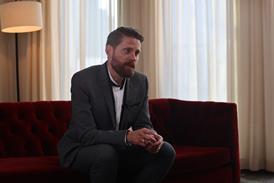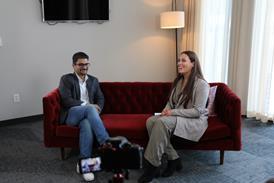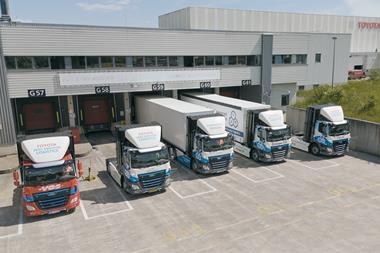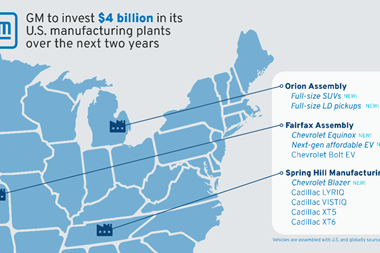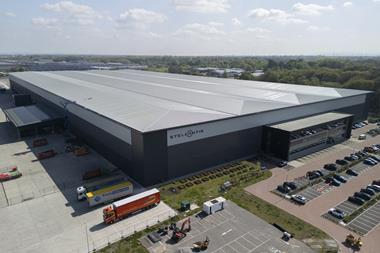With CKD operations crucial to many manufacturers’ global strategies, Anthony Coia looks at the issues of cost, reusability and customisation in packaging the vital kits
In the last issue of this magazine, BMW’s head of logistics, Dr Karl May, pointed out that new and persisting trade barriers hindering the importation of finished vehicles will continue to be a primary driver of CKD development, particularly in important markets like China and India.
 One of the most important factors to determine the degree of logistics efficiency in CKD shipping is the handling, consolidation and packaging of parts and components. Carmakers often rely on consolidation centres, run either in-house or by outsourced providers, to pack and prepare the kits before they are shipped to overseas markets. The packaging used–a mixture of returnable and one way, offthe- shelf and customised products–is an area that is arguably overlooked in the supply chain.
One of the most important factors to determine the degree of logistics efficiency in CKD shipping is the handling, consolidation and packaging of parts and components. Carmakers often rely on consolidation centres, run either in-house or by outsourced providers, to pack and prepare the kits before they are shipped to overseas markets. The packaging used–a mixture of returnable and one way, offthe- shelf and customised products–is an area that is arguably overlooked in the supply chain.
Indeed, as CKD production volume is low in comparison to standard production volume, its packaging rarely receives the same degree of attention as high volume shipments. However, the nuances involved in CKD shipments require the same degree of focus on packaging as for standard shipments. While the overall volume might be low, the inherently global nature of CKD operations means they move through longer supply chains and are often more difficult to pack efficiently than regular parts. There is a high amount of one-way packaging, for example, but manufacturers are also looking increasingly to packaging providers and logistics companies that might offer more returnable services.
At German engine manufacturer Deutz, Pascal Männche, senior vice president, logistics, says CKD packaging is essential to its operations. Its main markets are China, Algeria, Argentina, and the United States. Deutz serves five big plants and a smaller one in Brazil. In China, it serves two large plants and in January, it launched a smaller joint venture plant there.
During the ramp-up phase in new markets, CKD production often begins prior to localised production. “We use CKD as a part of our international strategy and we envision many possibilities for it. As such, we created a CKD/ SKD [semi-knockdown] management department about one year ago. Although we use only one-way packaging at this point, we are in the process of redesigning our system,” says Männche.
Unsurprisingly, Deutz’s objective is to improve packaging quality and handling while reducing the cost. Dr Mario Binder, head of CKD/SKD management, says Deutz uses mainly cardboard boxes for packaging following a switch in mid-2011: “We were using wooden for all CKD and then we changed to cardboard. This stimulated cost reduction in the packaging process. For example, it takes two people ten minutes to build one wooden case and one person only 15 seconds to prepare a cardboard one. This reduced our costs with the logistics service provider by at least 10-15%.”
However, cardboard is not a universal solution. For Algeria, where Deutz sends about 40% of its CKD tonnage for an agricultural tractor plant, it uses wooden boxes because cardboard is unstable. For this market, the customers organise the transport themselves, which involves trucking the packages from Cologne to Marseilles and reloading them into an ocean container for Algeria. For all of its other CKD operations, Deutz seals the packages in Cologne and also loads the containers.
As it investigates other packaging options, Deutz is also looking for better warehousing overseas. “In China, we are now looking at the warehouse storage conditions,” explains Männche. “Customers stack the boxes four or five high and pick directly from the box, which causes problems.”
 Binder adds that storage conditions are also an issue. “Plants use CKD packaging as storage and allow poor conditions for the parts with no heating or cooling. Thus there are quality issues and the packaging strength must be higher in China and Algeria.”
Binder adds that storage conditions are also an issue. “Plants use CKD packaging as storage and allow poor conditions for the parts with no heating or cooling. Thus there are quality issues and the packaging strength must be higher in China and Algeria.”
By contrast, customers in Argentina and the US usually repack their shipments, dispose of the CKD packaging and use returnable packaging for line feeding.
As a further improvement, Männche says that Deutz wants to skip full packaging by receiving the part from the supplier already in the correct packaging. “Because Europe uses all returnable packaging, the carton is extra handling for the supplier, and it wants to increase the price,” explains Männche. “However, the same size cardboard box is available and looks like a standard returnable for small parts. It holds the same quantity per container, say for 5,000 screws. This would save two to three days on order-to-delivery time in the packing process.”
Whereas Deutz provides the planning and control of its CKD operations, third party logistics provider Schnellecke Logistics manages the process. The process begins with Schnellecke providing milkruns from European suppliers in returnable containers to its CKD centres. There, it repacks, containerises, and ships the parts.
Upon arrival in the destination country, and depending on the customer, Schnellecke provides customs clearance and repacks the parts before delivering it to the point of use at the plant. From there, it checks, repairs, and returns the container. CEO Andreas Wagner says one-third of the total volume goes to point of use. “We pursue optimisation of each returning container. Volumes come in ten containers and return in two or three. We also want to minimise the variance in packaging from six to two. This involves reducing the number of shipped parts through preassembly,” he explains.
Schnellecke operates six CKD export centres: four in Germany and one each in Spain and the Czech Republic. The destinations include mainly emerging markets worldwide and the US. “We ship to approximately 40 plants–mostly where the Volkswagen brand is produced. Our packaging considerations are based on cost, lead-time, and quality,” says Wagner.
According to Männche, Deutz switched to Schnellecke recently from a smaller packaging provider. “Now, we have an international network with other automotive customers and better prices,” he says.
Most parts go in one-way packaging with less than 10% moving overseas in returnable containers. Wagner says that the type of packaging depends on the receiving country, including the distance, cost to return, the kind of part, etc. For example, for shipping engines to China, it would use one-way packaging.
“The true indicator is the total cost of inland and ocean transportation. It is about capital investment costs. If the pipeline is more than five to eight weeks long, we would likely use one-way packaging, which are cartons, wooden pallets, and plastic layers,” says Wagner.
For returnable shipments, Schnellecke uses steel and plastic packaging. For example, it ships powertrains in a specially designed returnable rack. For Russia, to which packages move mainly by rail from Germany, the returnable rate is the highest since the pipeline is not that long.
Premium carmaker BMW foresees considerable growth in demand for CKD shipping to developing markets. Interestingly for the German company, besides its primary packing centre for CKD in Wackersdorf, Germany, it also runs a significant CKD export operation near its plant in Spartanburg, South Carolina. Dr Bettina Böckle, head of packaging facilities, says the Spartanburg CKD operation comprises more than 100 parts manufacturers in North America.
 Most of the CKD packaging materials come from local suppliers that are located within a few dozen miles of the plant. “Repacking containers from returnable into one-way packaging to create the X3 series car kits is at the heart of the Spartanburg CKD operation,” says Böckle.
Most of the CKD packaging materials come from local suppliers that are located within a few dozen miles of the plant. “Repacking containers from returnable into one-way packaging to create the X3 series car kits is at the heart of the Spartanburg CKD operation,” says Böckle.
For BMW, the basic one-way CKD packaging is designed for single usage and thus is generally low-cost, modular cardboard boxes. Internal dunnage may consist of paper, foam, plastic bags and anti-static bags as well as cardboard dividers. It also uses a limited amount of wood for over-crating specific containers, some of which is recycled for multiple uses, according to Böckle.
Although most of BMW’s packaging material is standard, off-the-shelf product, some is specifically engineered for unique car components. Böckle says most of these materials are recycled at the foreign factories, which is important for following BMW’s mandate of environmental sustainability.
BMW’s use of one-way materials reduces the need for shipping returnable containers over long distances. “Since the CKD-receiving countries are far from our packing plant in South Carolina, it does not make economic or environmental sense to use returnable packaging. This is due to the long lead times and, consequently, the need for many containers in the loop. Furthermore, normally no backloads are available in the same volume,” she says.
At BMW, a packaging engineer determines the package design based on the unique requirements of the vehicle part. It is also considering using a common package which would provide economies of scale. With the launch of each new CKD car model, BMW begins a packaging improvement process, which considers the packaging compression factor, packing process ergonomics, cost efficiency and environmental considerations. “When we launched our X3 model in 2011, for example, we optimised packing compression, thus saving containers-worth of shipments,” says Böckle.
For manufacturers and their service providers, the objective is to improve the overall efficiency of packaging. “The biggest driver is cost reduction through the improved cubic utilisation of packaging as well as ocean containers,” says Arun Modgil, president of Ckdpack. He says that the main trend is per-kit pricing and costing rather than selling the packaging. “There is an increased number of CKD packages going from country to country, with more kits in containers. Therefore, the price per kit price is reduced,” explains Modgil.
Ckdpack brings together activities that combine packaging and logistics. For example, costing includes the complete end-to-end supply chain for CKD, including packaging design, supplying packaging, packing services, unpacking at the receiving end and return logistics management of packaging. It also provides day-to-day visibility of the location of the CKD part and packaging assets.
Modgil says that one of the trends in CKD production is to reduce the number of platforms for vehicle production. An OEM such as GM is now building the same car in Germany, India, China, Korea, and the United States, observes Modgil.
Parts are flowing in both directions between developed and developing markets, according to Modgil, such as engines from developed countries to developing ones and sheet body parts from developing countries to developed ones. It’s a trend he expects to continue. “There are a lot more exports to developing countries, but the trend is changing. Ten years from now, there will be a lot more from developing countries to developed ones.”
Vehicles produced in four to six locations around the world need different packages for reasons such as outside storage conditions and customs regulations. “Import restrictions make it easier to do one-way packaging, but the prospects for returnable packaging are improving. In addition, the complexity of the part is a factor. Engines go in enclosed or sturdy packages and sheet metal in less sturdy ones,” he says.
For Ckdpack, the solution is driven by the cost factor. For example, disposable packaging initially has an erratic volume. Parts tend to stay in the package longer as the operation starts up in the first one to two months, according to Modgil. Ckdpack offers returnable packaging solutions that have reduced engine shipping costs by 30% for Tata Motors compared to disposable packaging. “We also reduced end-toend delivered costs by 17% for General Motors for CKDs from South America to South Africa and from Thailand to South Africa,” says Modgil.
Among the companies offering CKD packaging is Clip-Lok International, which provides a two-piece solution in plywood. The sides and the clips that make up the closing mechanism hinge on a two-piece box. Anders Lassen, managing director, says that a challenge in the use of returnable packaging for CKD operations is the low yearly number of uses when shipping parts between continents. Therefore, an opportunity exists for reusing the packaging more times per year and for reducing the cost of packaging relocation.
“Traditionally, a CKD box is flat-packed after use and we return it to the sender for a new use. Instead of returning the box to the sender, another OEM in the same area can take over the flat-packed box and ship it to a CKD plant in another country. The end result would be lower packaging costs per part, reduced relocation costs, and lower CO2 emissions,” says Lassen.
Clip-Lok sees potential for its reusable packaging in shipping large parts, such as metal or plastic body panels, with a surface coating and fittings for cabins or engines. Another packaging provider, Group Dusogat, offers boxes that enable safe transport thanks to their sliding panels that divide fragile and heavy products in one single box. “We integrate our sliding and locking technology into existing packaging concepts,“ says CEO Felix Meyer-Horn.
 He points out that the ecological aspect of packaging is playing a more important role for customers. Dusogat’s products achieve a small carbon footprint since they are completely recyclable. “Through the use of our packaging technology, in combination with higher quality packaging, it is possible to reutilise the packaging several times, thus reducing the packaging costs. The challenge is in selling higher quality packaging. The use of 100% recyclable products is not yet a priority for everyone, but new laws are imposing stricter handling of packaging products,” he says.
He points out that the ecological aspect of packaging is playing a more important role for customers. Dusogat’s products achieve a small carbon footprint since they are completely recyclable. “Through the use of our packaging technology, in combination with higher quality packaging, it is possible to reutilise the packaging several times, thus reducing the packaging costs. The challenge is in selling higher quality packaging. The use of 100% recyclable products is not yet a priority for everyone, but new laws are imposing stricter handling of packaging products,” he says.
Dusogat has developed several new packaging solutions that enable it to introduce a new generation of CKD packaging units. The main improvement is the easy handling process that requires no tools and thus no additional labour. Meyer- Horn says that the technology reduces the assembly and dismantling time considerably, leading to savings between 20% and 60%, depending on the packaging size, destination, and whether it can be reused. “There are also other cost savings factors to consider, such as less labour to handle the packaging, considerable noise reduction, and easy handling that contributes to working in a comfortable and safe environment,” adds Meyer-Horn.
A prime example of the requirements of CKD packaging is at Renault, which produces its Logan model in a number of CKD plants worldwide. It uses logistics centres that are located in or near its plants in eight countries: France, Spain, Romania, Turkey, India, Korea, Brazil and Argentina. Renault uses a range of packaging that is adapted to international maritime transport and fits closely the dimensions of an ocean container.
Chantal Carraud, head of global logistics services, says that for its CKD operations, Renault uses disposable packaging such as cardboard and wooden boxes. It also uses returnable metallic packaging and stillages. “We use more disposable than returnable packaging. On average, 28-30% is returnable and our target is 40%. Some of our logistics centres use less than 10% returnable packaging,” says Carraud.
Renault develops its own packaging and sets up and manages its packaging pool. “For packaging, our main objectives are to optimise the container fill rate, which we have done. We are now optimising the fill rate for each package, which is the most important part of the process,” she says.
Renault’s main challenges include customs difficulties and lead-time specificity. Each country and plant has different specifications, which means a high level of complexity. Among the differences between CKD packaging and other automotive packaging is that the transport modal norms are not the same. “For CKD activity, we adapt all packaging for sea freight transportation,” explains Carraud. “Furthermore, overseas packaging has a lighter packaging structure since turnover is only three to four per year. By contrast, the turnover is every week to ten days for road transportation.”
Renault wants to develop its packaging in order to eliminate common quality issues such as the effects of wide temperature variations. The manufacturer is also taking steps to reduce waste and lower maritime or road costs as new environmental taxes are applied. Carraud points out that Renault’s external suppliers pack their own parts, while Renault packs the parts that it produces at its plants or logistics centres. The main purpose of its logistics centres is to consolidate all flows to one customer.
Among Renault’s main growth areas for CKD packaging is the use of metallic packaging over disposable and developing products that prevent corrosion. “We need to prevent corrosion inside the package or container. For example, parts that ship from Romania in January to Colombia or India may be vulnerable to corrosion,” says Carraud.
Renault has made significant efforts on its returnable packaging deployment. “We develop specific packaging for mechanical parts such as engines and gearboxes that are common for different types of flows such as sea freight and road. We standardise and have less diversity by using the same package for different engines or gearboxes. Now, we use packaging in compliance with overseas flows in order to achieve a better filling rate, whereas previously we used road packaging,” explains Carraud.
To provide sustainable, value-added packaging services for CKD parts, supply chain consultant Surgere uses a total cost optimisation approach that combines design, logistics and technology. It provides both returnable and one-way packaging, as well as container design and asset tracking for durable packaging.
Bridget Grewal, director of engineering, says its CKD module takes into account different wheelbases. “Our containers are flexible and can handle short wheelbases. Traditionally, shipping containers are different racks. With the new flexible design that we introduced last year, it can handle different sizes,” she says.
Grewal says that stackability is what creates savings, along with modularity. “The front tyres go in the rack similar to the rear wheels. Usually, we attach the front and rear racks and load them in a 53-foot van. We are trying for 8-16 vehicles per van, an increase from the 8-10 range,” she explains. “For modular vehicles, we ship the entire front module. We have to worry about shock and vibration. For example, for seats and the instrument panel dial, we reinforced the part with transport packaging, and for the seat we inserted polyethylene foam,” she adds.
Grewal says that among Surgere’s challenges is the fact that in engineering such low volumes for CKD shipments, it cannot invest in returnable packaging. “This must be considered at the beginning–different wheelbases and options taking up more space in truck. Planning is the most important aspect,” she says.
Surgere also includes economic variables in its packaging models. “For example, if packaging from Europe to Asia spikes, would it change the packaging materials used?” asks Timothy Nickel, the company’s vice president of operations.
David Horvat, Surgere’s director, information technology, adds that tracking is also an important part of the packaging supply chain. “The barcode or RFID tag for each container is serialised, which tracks cycle time and loss. This enables us to predict what will happen and where shortages would occur, in order to keep the production line going. It also predicts fuel costs as a means of facilitating packaging and has improved the performance of RFID tags.”
With CKD operations at the cornerstone of many manufacturers’ globalisation strategy, the relevance of an efficient and effective packaging system is apparent. The question of using returnable versus one-way containers is largely an issue of cost and will likely remain as such, even as CKD logistics continues to improve in efficiency. But the scope for 3PLs and packaging providers to provide alternative options and enter new markets in this area appears to be considerable and growing.




